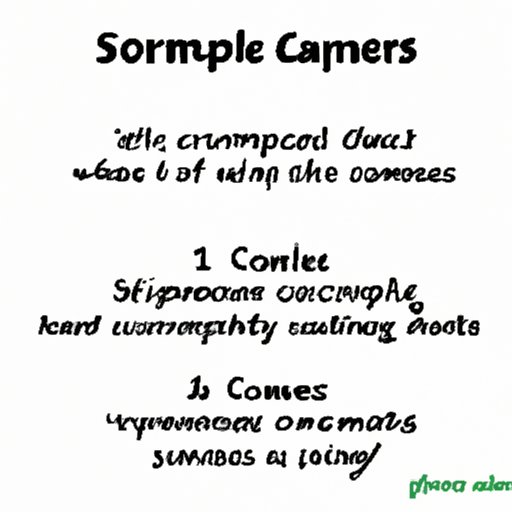Introduction
Have you ever been unsure whether you’re using a comma correctly? Maybe you’ve been told that you’ve committed a comma splice, but you’re not sure exactly what that means. If this sounds like you, you’re not alone. It can be challenging to understand and use proper punctuation, especially when it comes to commas. This article will discuss all things comma splices, from what they are and how to identify them, to the negative impact they can have on your writing style and credibility.
The Art of Identifying Comma Splices
First things first, let’s define what a comma splice is. A comma splice occurs when two independent clauses are joined together with only a comma. For example:
I woke up early this morning, I decided to go for a run.
This sentence contains a comma splice because “I woke up early this morning,” and “I decided to go for a run.” are two independent clauses that could stand on their own as separate sentences.
Comma splices are often mistakenly used because they are commonly found in conversational English. For example, when we speak, we tend to use more run-on sentences as we think on our feet. However, in written English, comma splices are considered errors because they can greatly affect the clarity of the sentence.
The Costly Mistake of Comma Splices
As mentioned, comma splices can negatively impact the clarity of a piece of writing. When a comma is used to connect two independent clauses, readers can become confused about the relationship between the two ideas. This confusion can cause readers to have to re-read the sentence, making the text awkward and frustrating to read.
Comma splices are particularly damaging when found in professional or academic writing. In these settings, clarity and professionalism are highly valued, and a mistake like a comma splice can harm the writer’s reputation. Imagine reading a legal document that contains comma splices, or a scientific report with unclear connections between important information.
Common Grammar Pitfalls
Comma splices are just one of many common grammar errors that writers make. Other common mistakes include run-on sentences, subject-verb agreement errors, and incorrect apostrophe usage. All of these errors can negatively affect the clarity and credibility of a piece of writing.
Comma splices, in particular, are considered a writing “no-no” by many writing professionals. They are easy to spot, and therefore, easy to fix. However, writers who struggle with punctuation may find it challenging to spot a comma splice, even when it’s staring them in the face.
The Dos and Don’ts of Using Commas
To avoid comma splices, writers need to understand when and how to use commas appropriately. Commas should be used to separate list items, introduce a quotation, and separate phrases within a sentence. They should not be used to join independent clauses.
Common comma mistakes writers make include using a comma instead of a period, inserting unnecessary commas, and using commas in a series of phrases that don’t require them. For example:
She went to the store, bought some milk and bread.
This sentence contains an unnecessary comma after “store,” which interrupts the flow of the sentence.
Breaking the Splice: Tips and Tricks for Overcoming Comma Splicing Errors
If you want to avoid comma splices and other common grammar errors, there are several things you can do. First, consider using a grammar checker tool like Grammarly or Hemingway, which can identify and provide corrections for comma splices.
Additionally, practice your comma usage by reading and studying examples of good comma usage. Focus on sections of writing that use commas correctly and try to identify why the author chose to use a comma in that specific location.
You can also try rewriting sentences that contain comma splices to avoid using a comma. For example:
He is studying for the exam, he has been studying for hours.
This sentence contains a comma splice that can be easily fixed by using a semicolon instead:
He is studying for the exam; he has been studying for hours.
The High Stakes of Comma Splices
Fixing comma splices and other common grammar errors can greatly improve your overall writing style. Consistently producing well-written, grammatically correct pieces can establish you as a credible and reliable writer.
In professional and academic settings, the cost of not fixing these mistakes can be high. It can affect your reputation, as well as your ability to communicate your ideas effectively. By taking the time to master good comma usage, you can set yourself apart from others who may be less comfortable with the intricacies of the English language.
Conclusion
In conclusion, comma splices are a common grammar error that is easily fixed with attention and practice. By understanding how comma splices work and practicing good comma usage, writers can improve their overall style and credibility. Remember, when in doubt, it’s always better to err on the side of caution and avoid using a comma splice.
